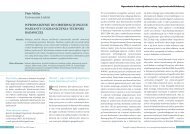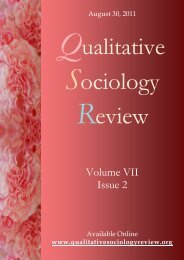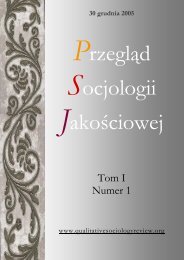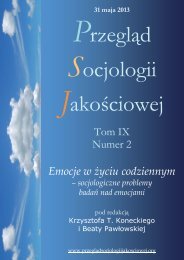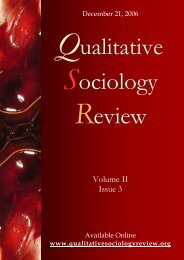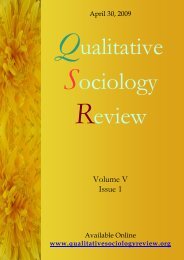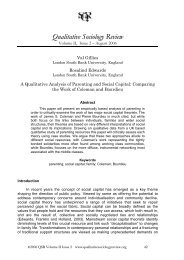volume IV is 3 - Qualitative Sociology Review
volume IV is 3 - Qualitative Sociology Review
volume IV is 3 - Qualitative Sociology Review
You also want an ePaper? Increase the reach of your titles
YUMPU automatically turns print PDFs into web optimized ePapers that Google loves.
The Story and its Telling<br />
The driver’s license story <strong>is</strong> organized around several sub-themes like deciding<br />
to get a driver’s license, learning to drive, buying a car and so on. These sub-themes<br />
form a part of a temporally progressing story with some events happening first, and<br />
then giving place for succeeding events. Th<strong>is</strong> progression constitutes a higher order<br />
temporal organization of the story.<br />
When Martha tells her story th<strong>is</strong> higher order temporal organization of the<br />
narrative <strong>is</strong> problematic and even m<strong>is</strong>sing. That <strong>is</strong>, the temporal relation between the<br />
sub-themes <strong>is</strong> broken up and the sub-themes are told without any internal temporal<br />
organization. Further, some sub-themes are told over and over without Martha noting<br />
it or being concerned about th<strong>is</strong> repetition. Martha’s rendering of the sub-themes of<br />
the story in contrast, are generally well organized, and told in a similar way and<br />
generally end with an evaluation of the events.<br />
In all these instances, the interactional organization has a similar structure: the<br />
audience <strong>is</strong> drawn in together with Martha, the teller, in appreciating the point of the<br />
story, and those parts of the story that are related to its evaluation. Evaluations are<br />
very important in storytelling, as it<strong>is</strong> one of the most prominent means a teller can use<br />
in order to convey to the l<strong>is</strong>teners why the story <strong>is</strong> being told. It <strong>is</strong> also a way to<br />
position the teller in relation to the events in the story. Th<strong>is</strong> can be done either<br />
through the teller commenting on what happened or by the teller having some of the<br />
characters in the story deliver a comment. In the latter case the teller often quotes<br />
some person allegedly commenting on the events that took place.<br />
In the example below Martha tells her story to her co-patient Catherine while no<br />
staff member <strong>is</strong> present. Just before the start of the example Martha has been<br />
relating to Catherine that her husband did not believe she could save money to buy a<br />
VW car. Th<strong>is</strong> part of the story, organized around her husband’s d<strong>is</strong>belief, ends with<br />
the evaluation we see in the following example. In the transcription non-verbal<br />
aspects are added, as they are quite important in understanding what <strong>is</strong> transpiring.<br />
Example 1<br />
(1) Martha: ((seeking eye contact)) “oh ss sure I can” I said<br />
(2) [“one can”]<br />
(3) Catherine: [(xx xx)]<br />
(4) Martha: “one can do whatever one wants to” [I said]<br />
((turning the upper part of her body towards Catherine, leaning against her<br />
and maintaining eye contact during the whole utterance. At the same time<br />
she pats Catherine on the arm with a slow and dramatic gesture, timing the<br />
bodily contact so as to further underline the word “whatever”))<br />
(5) Catherine: [yes]<br />
(6) that’s true ((nodding))<br />
(7) Martha: yes<br />
(8) and then one does not give up until one <strong>is</strong> there<br />
((marking the beginning of the line with two downward strokes with her f<strong>is</strong>t<br />
and the stressed word in the end of it with a short nod accompanied by eye<br />
contact))<br />
(9) Catherine: =no<br />
(10) Martha: and one <strong>is</strong> about to do it<br />
((ra<strong>is</strong>ing her loosely clenched hands so as to underline the stressed part<br />
maintaining eye contact during the whole utterance))<br />
(11) Catherine: =yes<br />
©2005-2008 <strong>Qualitative</strong> <strong>Sociology</strong> <strong>Review</strong><br />
Volume <strong>IV</strong> Issue 3 www.qualitativesociologyreview.org<br />
54



